By Jeffrey A. Rendall, Photos By Jeff Janas
HOT SPRINGS, VA – If there’s one thing you’ll take from golf school, it’s that next time you head to the golf course, you won’t forget your GAS.
We’re not talking about the stuff you put in your car’s fuel tank, and it has nothing to do with how much physical stamina you’ll need to finish a round of golf, either.
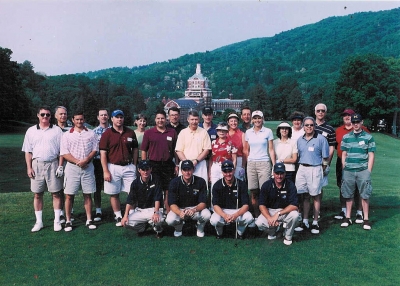 |
| The Homestead Golf Advantage School Class of late May, 2004. Front row instructors, from left: Eric Hooke, Mark Fry, Brian Painter and Barry Ryder. Photo By Verner Gattinger. |
GAS, as I learned from attending the Homestead’s Golf Advantage School, means Grip, Alignment and Stance. Too many times, at least for me, I’ve teed it up on the first hole with a head full of swing thoughts – keep the left arm straight, don’t sway the hips, swing to right field, let the club fall on the downswing, load up the right side for power, don’t dip your head, shift your weight to the front side when striking the ball, grip the club like you’re holding a dove, keep the clubface square on the takeaway, hit from the inside, rotate your forearms, release the club… etc, etc.
All of those are good thoughts (perhaps not all at once), but according to Mark Fry, Director of the Homestead’s Golf Advantage School, if you’ve got GAS on your side, you’re well on your way to golfing success: “Our whole philosophy when conducting our schools is to build the golf swing around set-up fundamentals, which are grip, aim (alignment) and stance. Once you’ve got fundamentals, you’ll develop swing tendencies, and we can work on those separately, bad or good.”
Fry’s been teaching at the Homestead for ten years, and he’s seen lots of golf swings in that time. It may be true that each swing is unique, but those standard GAS fundamentals are etched in stone at golf’s monolithic temple – perhaps chiseled by Bobby Jones, Ben Hogan and the Homestead’s own, Sam Snead. But it doesn’t matter how long you’ve played, if you’ve developed a problem, it’s probably because your fundamentals aren’t where they should be.
That’s why you’ll learn the right way to start at the Golf Advantage School.
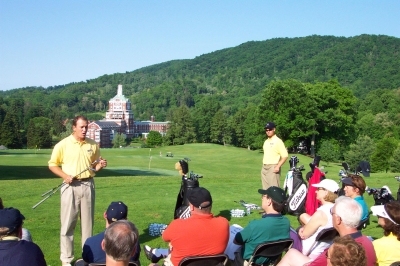 |
| Mark Fry presents the morning clinic with Brian Painter and the class looking on. With the Homestead Hotel as the backdrop, it's hard to imagine a more beautiful setting. |
Fry says even professionals need a GAS check-up every now and then: “Though I’d say here at the golf school we work mostly with mid to high-handicappers, I also work with JC Snead (nephew of Sam Snead) – and he was out here just the other day, working on posture (stance). Here’s a guy who’s won eight times on the PGA Tour and four times on the Champions Tour -- one of the leading money winners of all-time, and he’s got a fundamentals problem.”
“It’s easy to develop bad habits, even at that level, so that’s where we place the emphasis in our teaching programs, making sure students learn the essentials for success in the game – so you develop a routine where you stand correctly every time, then discover your swing tendencies and try to cure or fix those, or at least better them as you practice,” Fry added.
Having previously attended two other golf schools, I knew what to expect from the experience – a fun learning environment to be sure, but also not your typical golf trip or vacation. The Homestead’s program involves fifteen hours of instruction spread over three days, including two hour-and-a-half long playing lessons on the first two days of the school. If you’ve still got any ‘gas’ left after the formal sessions, you’re free to golf on your own, or on the afternoon of the third day.
 |
| Looking back towards the tee of the Old Course's 1st hole -- the oldest tee in continuous use in the United States. Golf School participants can play it as part of the school package. |
Fry’s opening remarks to our group told us what to expect from the school: “I tell my students right away that golf school is not a 30-minute lesson – so you need to be very open-minded, understanding that you’re going to receive a lot of information to process. That’s why we have three days to learn, and work on things.”
He continued, “Discipline and patience are the two key words to keep in mind. You have to approach it from the standpoint that you’re not afraid to take one step back to possibly take two steps forward. And probably the toughest challenge for us is sometimes convincing a golfer who’s played for a long time to change their grip or make this or that modification. You’ve come here, presumably, to try and get better – and it’s very important to be patient in that process.”
He also let us know that it’s not all fun and games, despite being at one of the world’s most beautiful resorts: “People who come to the school are here to learn – they’ve signed up for 15 hours of golf instruction, and that means they’re not going to get a lot of time to go to the Spa and take part in some of the other things at The Homestead.”
That’s a considerable sacrifice, but no one’s ever complained.
 |
| There's ample room to hit from the Golf Advantage School's practice tee. |
“I’d say it’s kind of a combination of a vacation and working hard, if that sounds right. Each one of our instructors is very prideful – they want you to learn and get better just as much as you do, and that takes some hard work. But it’s also fun. It’s not really a true vacation, but on the other hand, it’s not boot camp either,” Fry mused.
Fry pointed out that school will be tougher on some than others, depending on physical condition, stamina, and how much golf experience they have. He says he’ll get some beginners who just need to be pointed in the right direction and eased into things, but he also sees the robo-practice types who’re itching to empty their large baskets of range balls before time’s up to switch to the next station. It’s finding the right mix of instruction, practice and rest that makes the Golf Advantage School successful, and I’m happy to report, that’s been achieved.
Somewhat of a departure from my previous golf school experiences, the Homestead’s school featured more than one instructor (four), along with a fairly large class of students (20). To handle the large school, Fry had plenty of professional teaching help in Barry Ryder (Head Professional at The Cascades), Brian Painter (Head Professional at the Lower Cascades) and two-time Virginia State Amateur Champion, Eric Hooke (Assistant Professional).
 |
| The Homestead Hotel at sunset. Looks just as grand morning, noon or night. |
Each day’s school was divided into three one-hour and fifteen minute instructional practice sessions for full-swing, pitching/bunker and putting/chipping, where the different instructors would focus on one area – Fry and Ryder on full-swing, Painter on putting and chipping, and Hooke kept things light and loose in pitching and bunker play (just remember one thing – ‘dig’).
The multiple instructors provided a good change of pace for the school – and all being consummate professionals, there wasn’t a personality conflict to be found. As Fry indicated above, each instructor is focused on teaching the proper technique, but also maintaining the atmosphere of camaraderie and fun.
A good example was Brian Painter’s putting contest on the third day – he’d gone over chipping and putting techniques, routines and strategies the first two days, and wanted to introduce a little ‘competitive pressure’ for the final session. Painter devised a nine-hole course featuring all sorts of putts you’ll find in a normal round, and even encouraged a little good natured ‘razzing’ amongst the contestants to try and add a little extra stress to the moment.
One caution point flashing through my mind when I discovered there was going to be more than one instructor -- was the potential for being told multiple cures to my multiple ailments. It’s tough enough to go to golf school and try-out new thoughts from one person’s mind, how would it be to pick the brains of four new teachers?
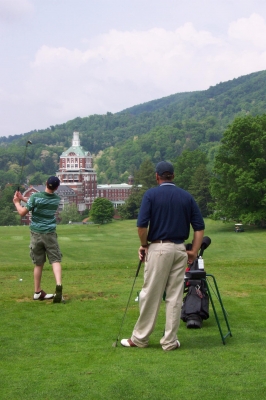 |
| Barry Ryder looks on as student Joe Petruska hits a shot. Ryder's been at The Homestead for over 20 years, and his teaching tips reflected that experience. |
Communication amongst students and instructors solved that right off, and Fry says they handle those issues well in advance. “One think I always preach to my instructors, especially when we have guest instructors (as they do at times for specialty schools), is the need for continuity. Being consistent is crucial when you’re dealing with what might be defined as ‘fragile’ golf swings.”
“Sometimes people take things so literally,” Fry added. “It’s very important as people go from one station to the next that every instructor’s on the same page, and that hopefully seeing some of the same similarities, whether it’s a grip issue or a postural problem. What you don’t want to happen is when a student’s just come from full-swing, and maybe gotten one or two, and hopefully not more than two or three thoughts or corrections – you don’t want to add three more at the next station. All of a sudden it gets very confusing.”
Fry nips that problem in the bud by encouraging his instructors to communicate with the students, asking about what’s being worked on in the other sessions, and re-enforcing the techniques rather than changing things around. Contrary to my opening impressions, working with different personalities and styles was a refreshing distinction from the past. There are certain merits to each way – studying under one teacher, and also having several at the same time.
 |
| Late afternoon shadows and sunlight highlight the Old Course's 2nd green, with the Homestead Hotel always in the background. |
With more instructors, you make more friends. Same with more students – we had a great time getting to know each other, and eating lunch as a group fostered that camaraderie even more.
Each day’s full-swing session included video analysis, something I’d encountered in the previous schools. Change is a difficult thing for all of us to accept, and for those who’ve never had a lesson or attended a golf school, you may be in for a shock when you find yourself in front of a camera, then a video monitor. There’s been many a teaching pro who’s said that you really don’t know what you look like swinging a golf club until you’ve been video-taped, and that’s the truth.
But the tape doesn’t lie. It also isn’t golfing gospel, just a place to start – and Fry’s computer analysis mercifully wasn’t frame-for-frame.
“The video is just a tool, in my opinion, for you to verify what the instructor’s seeing out on the practice tee,” Fry said. “It helps the student visualize what we’re observing and how it applies, and then we can compare your moves against certain professionals so you can see how someone’s doing it correctly and learn from it.”
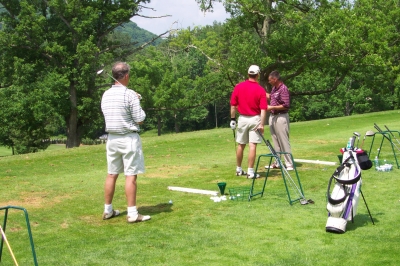 |
| Students pause to listen as Ryder explains another idea. |
But don’t be a video hawk. “A lot of people get in that room and want to see it over and over, which really isn’t productive. Remember, we’re talking about a few prospective changes here, and you’re not going to look like Ernie Els over night,” Fry added.
Another departure from some of the earlier golf school experiences was the total absence of swing aids. Fry says they do have some and use them occasionally, but they prefer to teach more from a ‘feel’ standpoint, and don’t necessarily want to use swing aids that students will feel obligated to go home and buy once finished with the school.
“In a perfect world, an instructor would be able to decipher whether a student is analytical or they’re a ‘feel’ type player – and a good instructor could probably teach either way. There’re probably ten different ways to say the same thing in relationship to the golf swing, and as a whole, I’d say we’re a bit more ‘feel’ oriented to try and help players sense what they should be doing,” Fry instructed.
 |
| Golf's a centerpiece at The Homestead. The practice putting green's just a short walk from the hotel, and the fleet of carts is ready for the next day. |
Because they tend to get a few more beginners and higher handicappers, too much terminology can be a bad thing. “We can talk about fancy terms like lag, and hinging early, and over-the-top, and across the line – but then you’ve got a beginner standing there, and he’s scratching his head because he doesn’t have a clue what you’re talking about,” Fry said.
“We try to keep it simple,” Fry continued. “That’s why we don’t use a whole lot of swing-aids. We’ve got the Inside Approach, and impact bag and some putting aids. But I’ll also use things like head covers to demonstrate swing path, which can be very helpful if properly used. But we don’t use them a whole lot because if you use them here, you’re almost asking students to go home and buy them. We want to use things that people can use when they leave right away.”
A final piece of the complete Homestead Golf Advantage School experience is the two on-course playing lesson sessions on the first two days. Fry’s views differed somewhat from other schools’ philosophies on playing lessons – which were a bit hesitant to take students out on the course while you’re still learning to hit that seven-iron solid.
“The bottom line is, you can practice mechanics and hit balls all you want, but until you take it to the golf course, it’s certainly useless,” Fry said emphatically. “It’s always a struggle to try those changes on the course, but it’s also very important. We’ve had many, many comments from students who’re asking to actually do more time on the golf course, so we try to reach just the right balance. I don’t want my school to be a three-day swing fest where you hit 5,000 balls on the practice tee and never talk about things like course strategy and etiquette.”
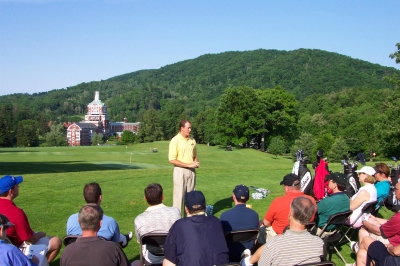 |
| Fry and the other instructors practiced what they preached -- it was easier to visualize the concepts when we saw them demonstrate how to perform them. |
Fry’s got a point. There’s certainly more to the golf learning process than mastering the point of contact with the ball. And there’s more to the Homestead experience than just the golf school (even while you’re attending). The Golf Advantage School package includes breakfast, lunch with your schoolmates (you receive a menu every morning, with a pretty extensive selection of cuisine) and dinner in the Main Dining Room, the Casino Club Restaurant or across the street at Sam Snead’s tavern.
Food and outstanding service are part of the Homestead Golf Advantage School experience – and if you plan it right, there’s time for some of the other offerings, such as the Spa.
It’ll depend on your appetites and endurance levels, on just how much you’ll be able to do. Of course, there’s certainly nothing wrong with spending your spare time on relaxing at the pool or strolling the grounds.
It’s all fundamental to enjoyment, with plenty of GAS to spare.
Note: See links below for an overview of The Homestead Resort, as well as GolfTheMidAtlantic.com course reviews of its three golf courses – The Cascades, The Lower Cascades and The Old Course.
Details:
The
For additional information on the
Website: www.TheHomestead.com/golf/school.asp
Director: Mark Fry
Instructors: Barry Ryder, Brian Painter & Eric Hooke
Director of Golf at The
2004 Schedule and Tuition:
|
Weekday |
|
Weekend |
|
| |||
|
Single |
Double |
Non Participant |
Single |
Double |
Non Participant | ||
|
$1,399 |
$1,199 |
$650 |
$1,599 |
$1,299 |
$650 | ||
|
|
|
|
|
| |||
|
Weekday Seasonal |
|
Weekend Seasonal |
| ||||
|
June 20-23 |
|
June 2-27 |
|
| |||
|
July 11-14 |
|
July 8-11 |
|
| |||
|
July 25-28 |
|
July 29-August 1 |
|
| |||
|
August 1-4 |
|
August 12-15 |
|
| |||
|
August 8-11 |
|
August 26-29 |
|
| |||
|
September 12-15 |
|
September 9-12 |
|
| |||
|
September 19-22 |
|
September 23-26 |
|
| |||
|
October 3-6 |
|
October 23-26 |
|
| |||
|
October 10-13 |
|
|
|
|
|
| |
There are special schools available. Call the above number for information.
| Related Links | Comments on this article? | |
|
Maryland National Golf Club Hollow Creek Golf Club Rocky Gap Resort PB Dye Golf Club in Ijamsville Whiskey Creek Golf Club |
E-mail Jeff Rendall, Editor: jrendall@golftheunitedstates.com |












